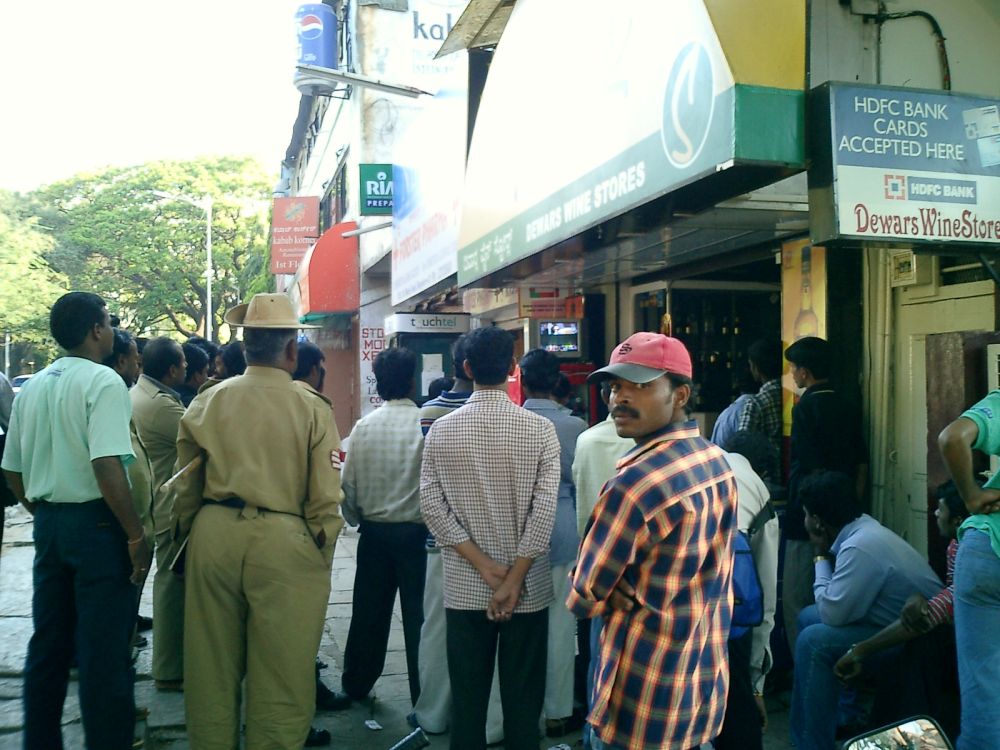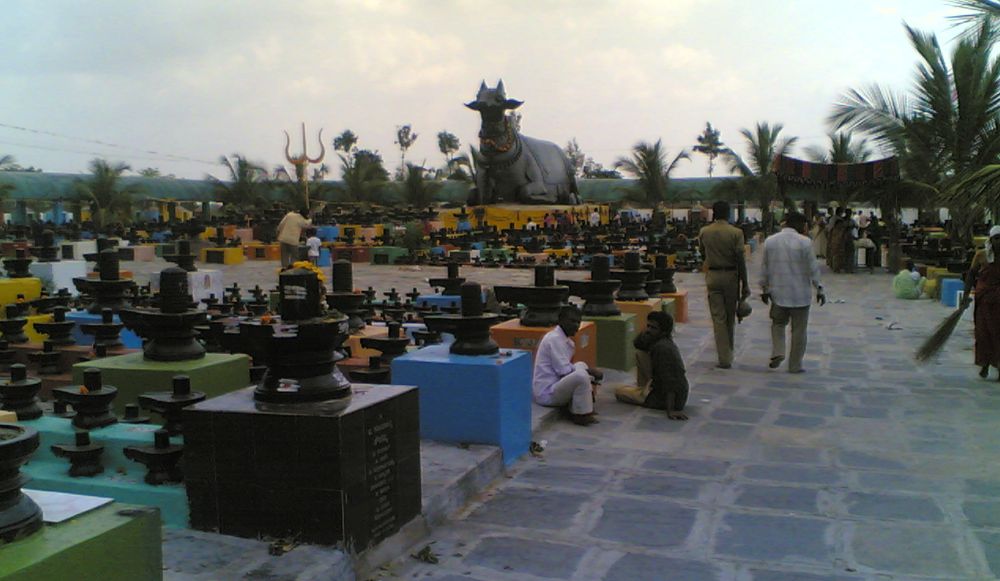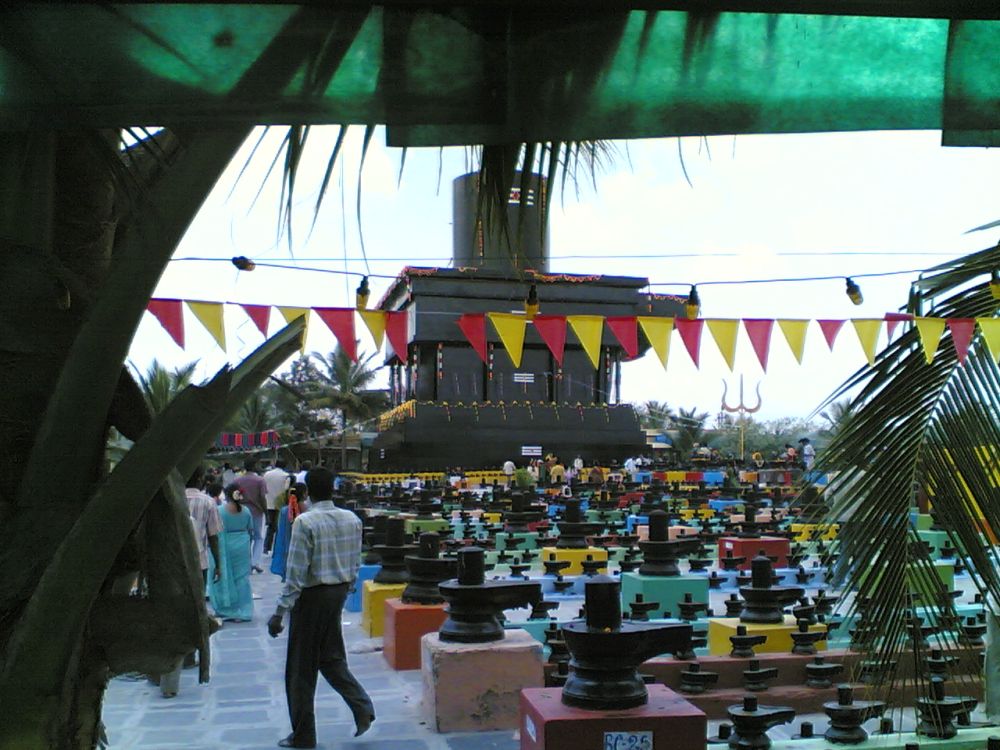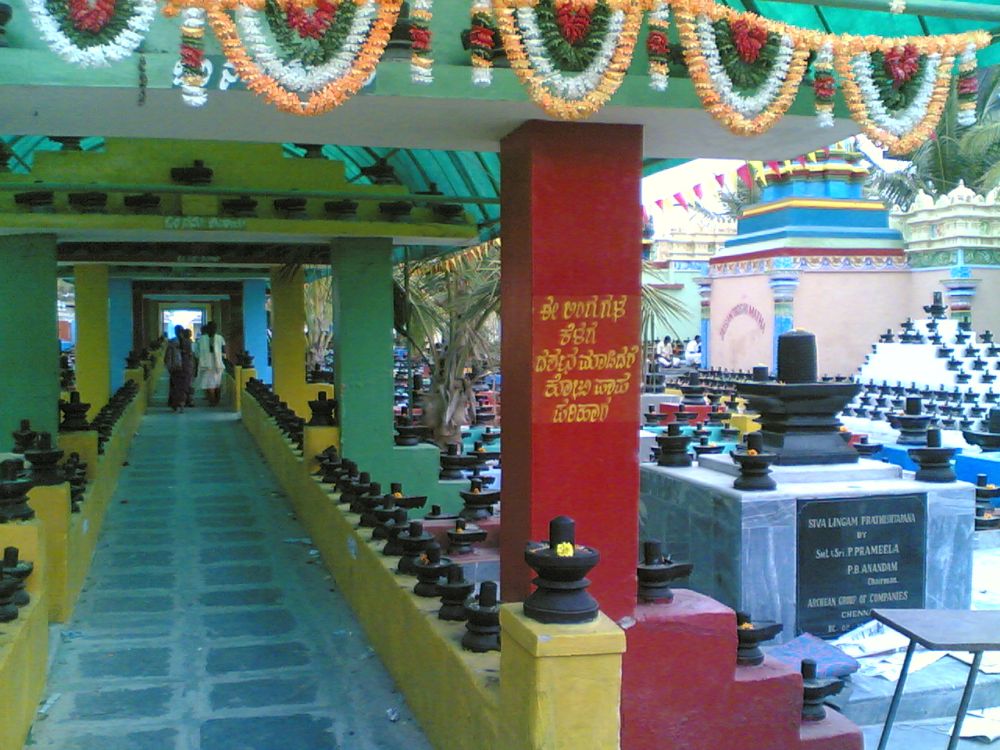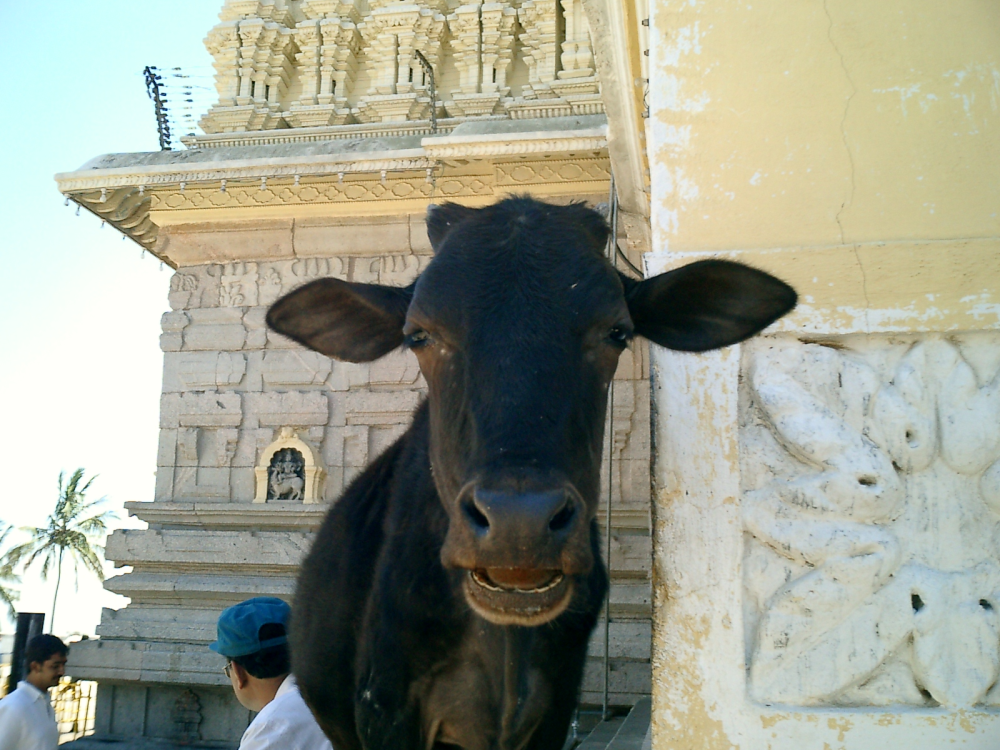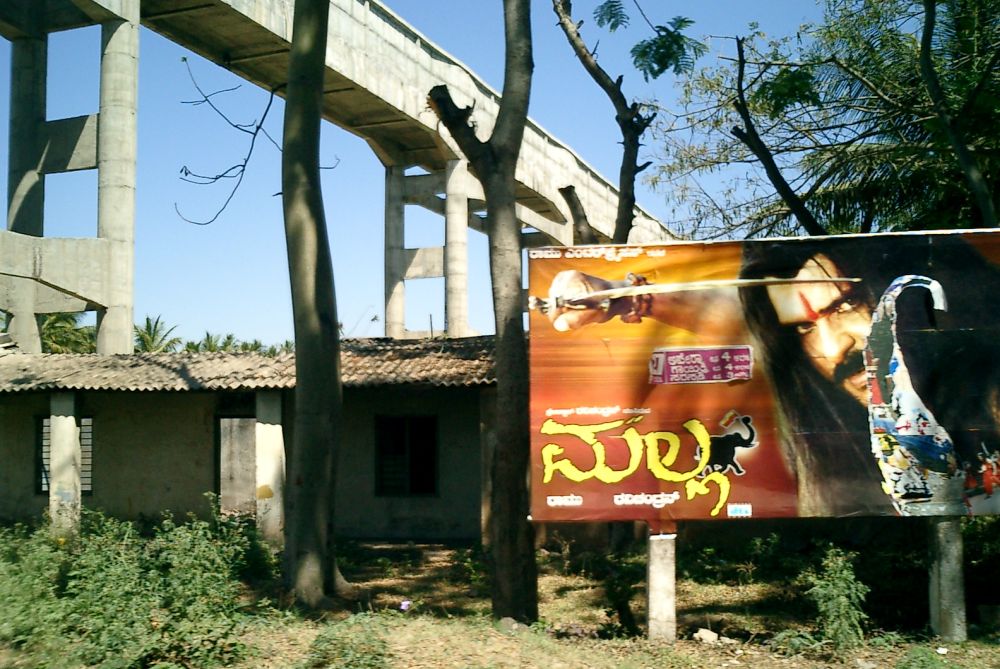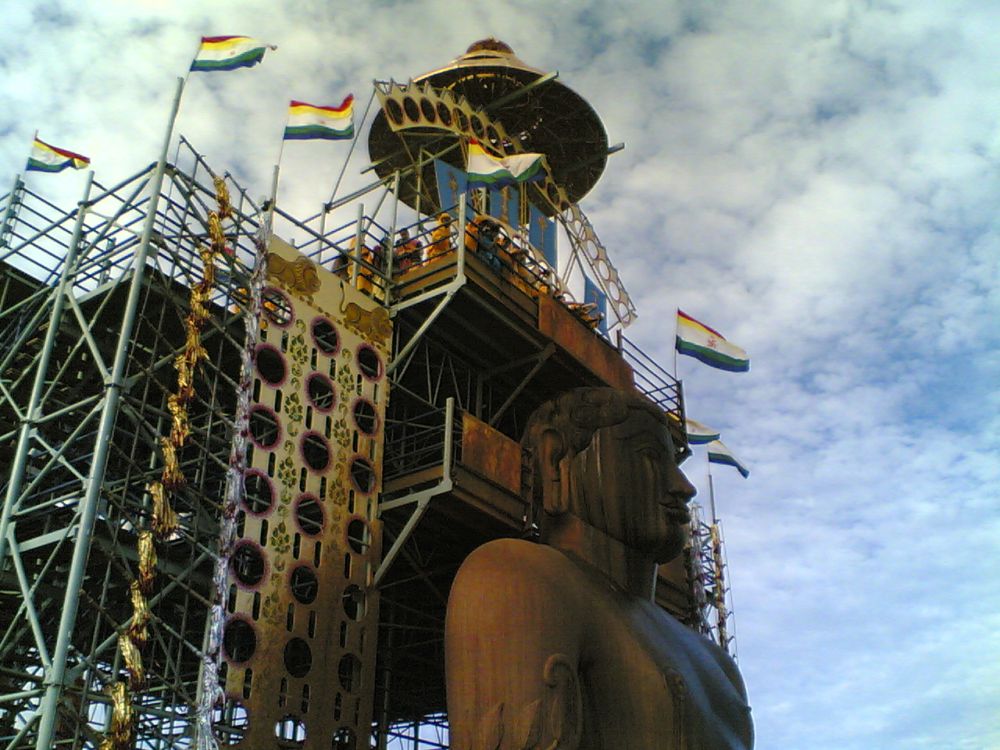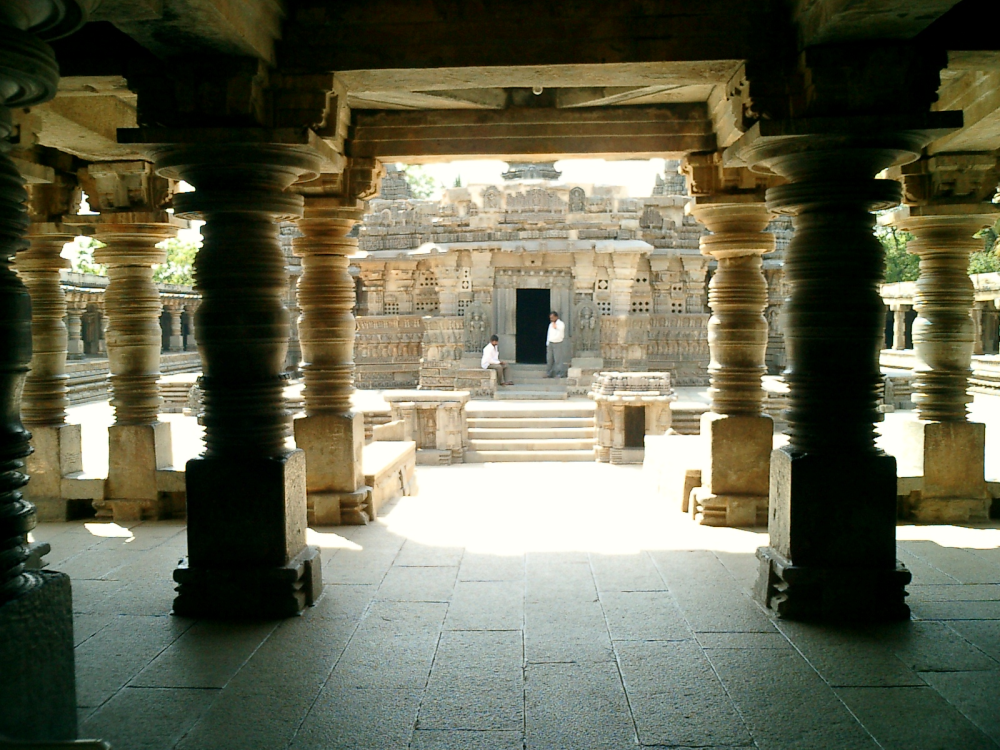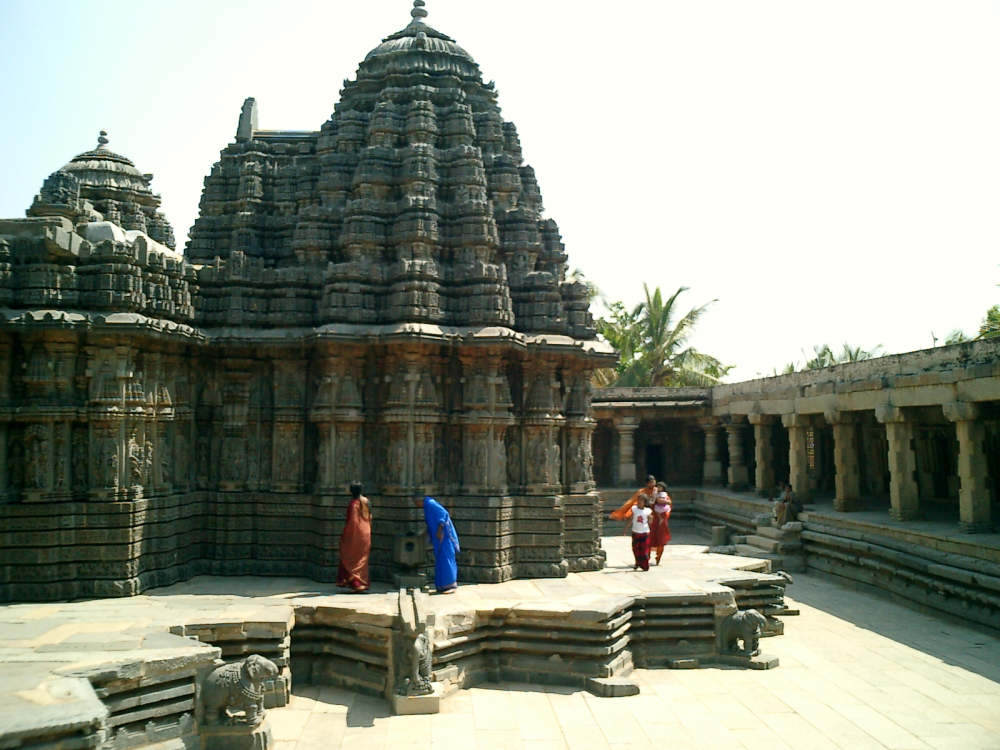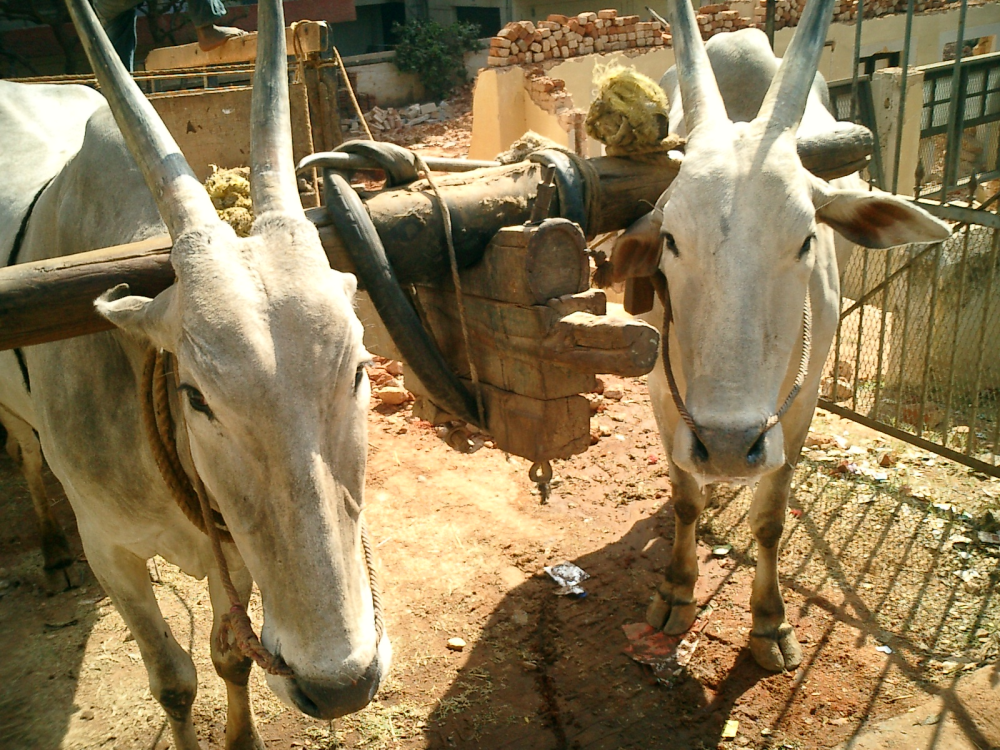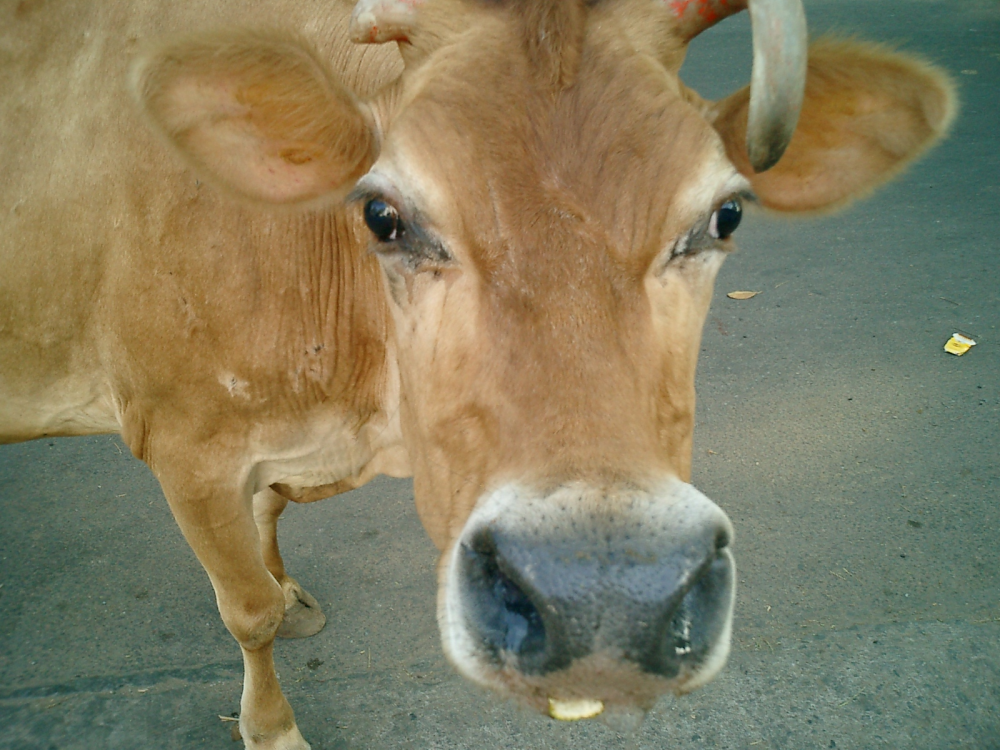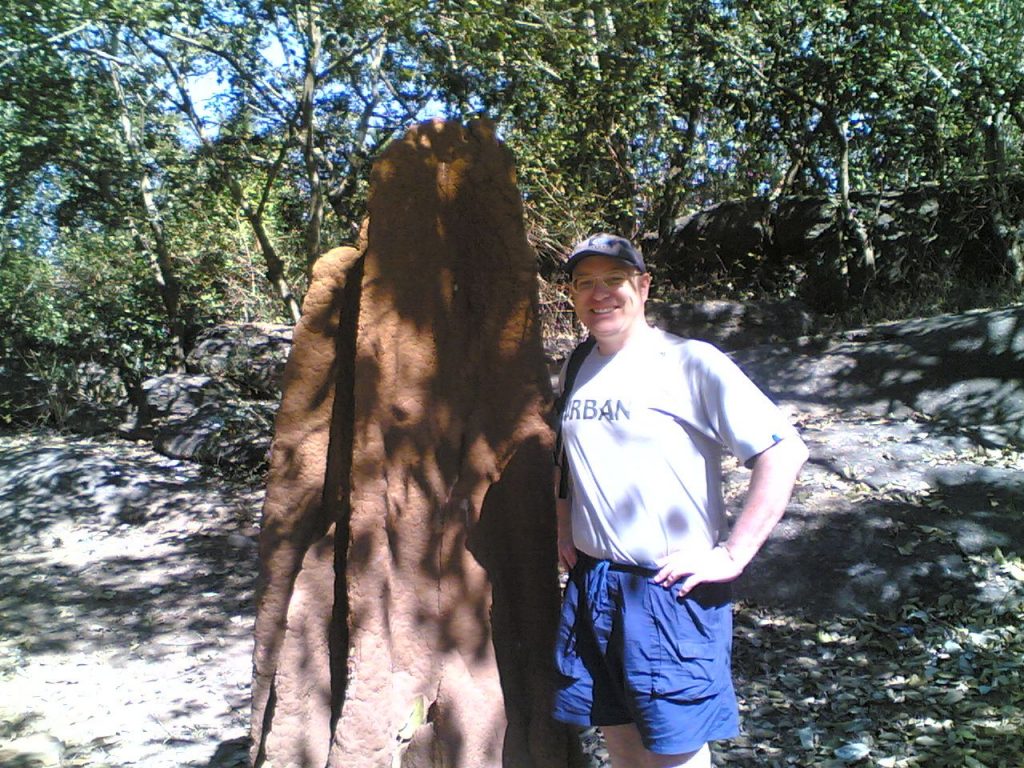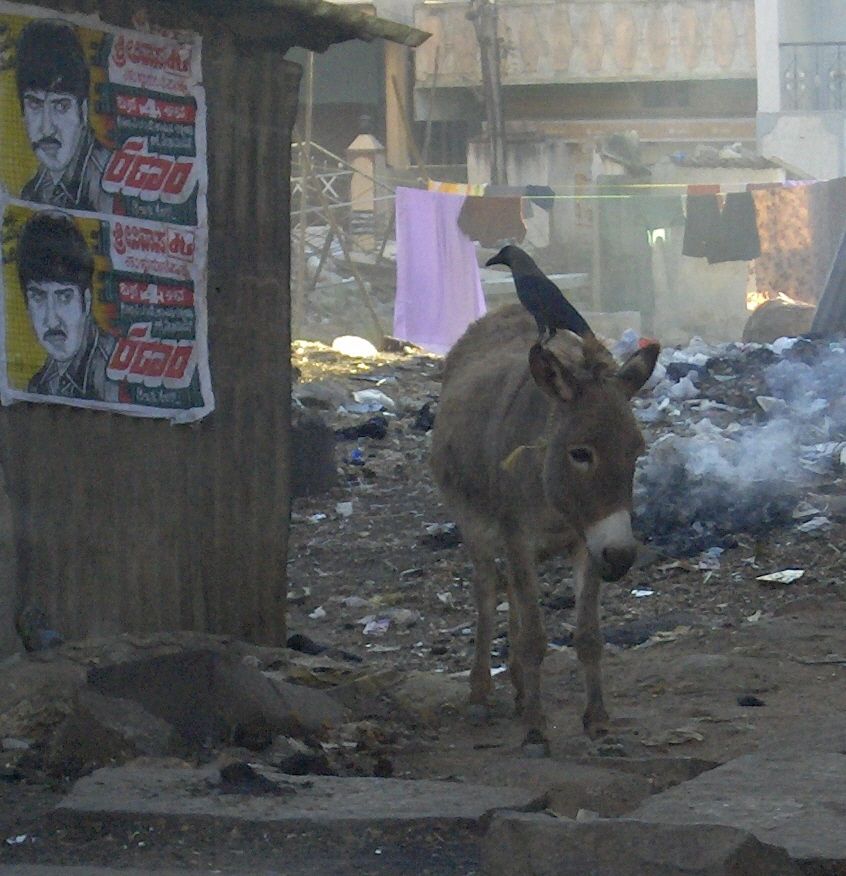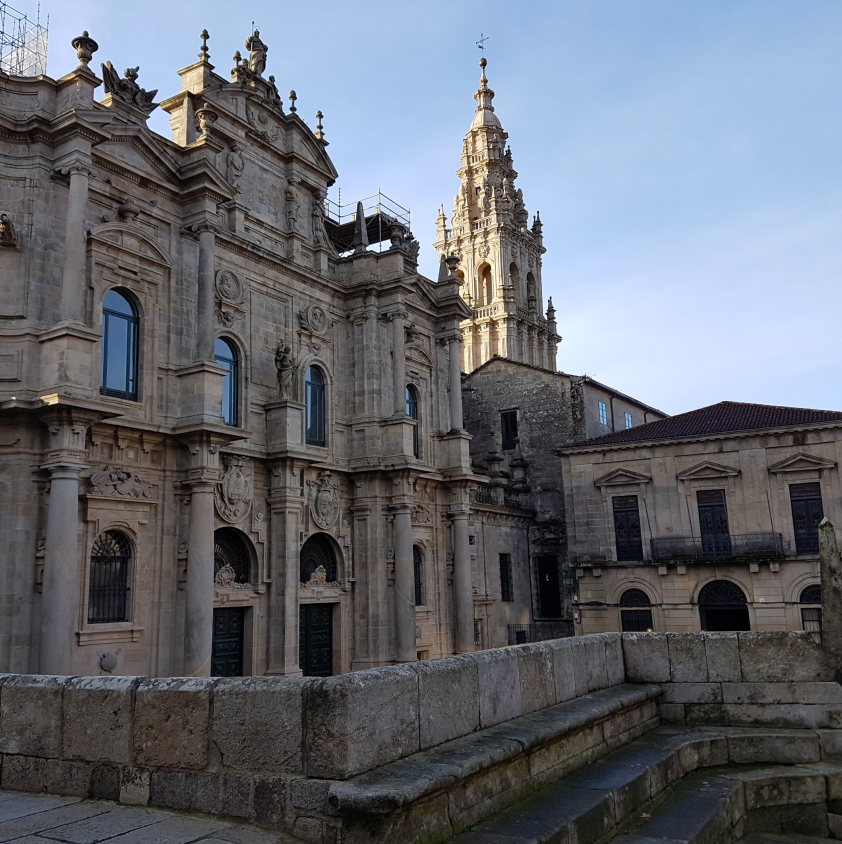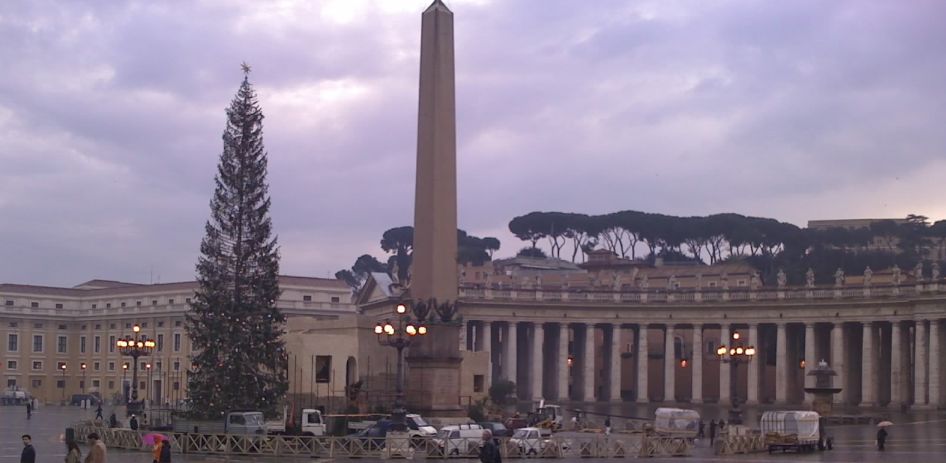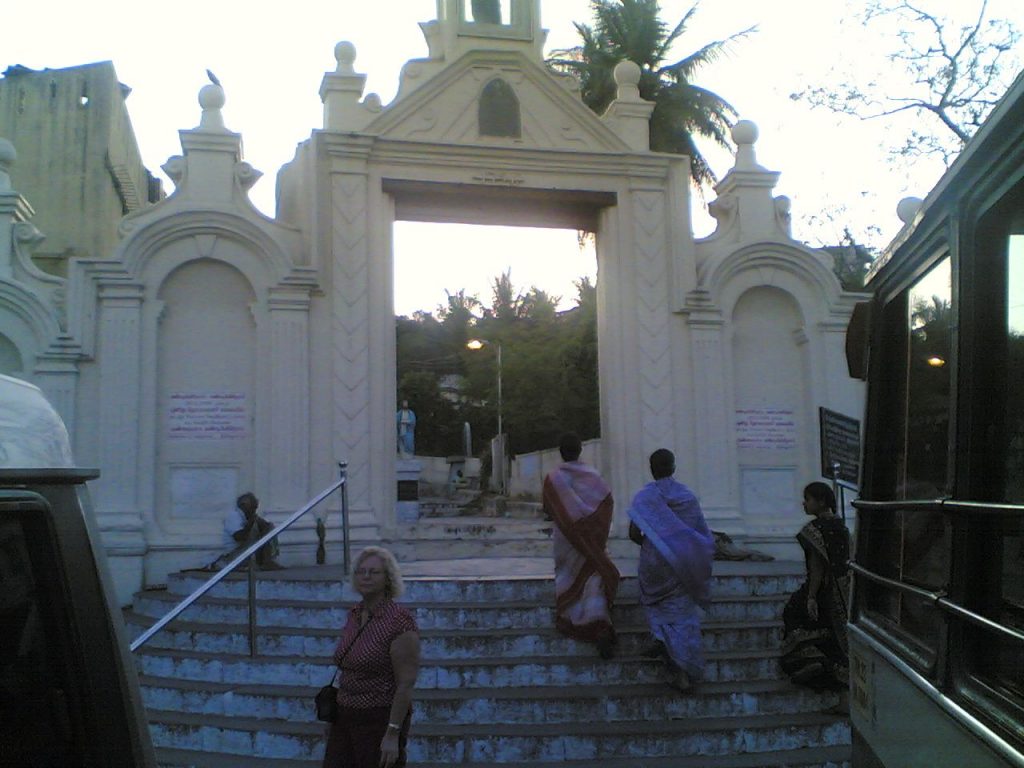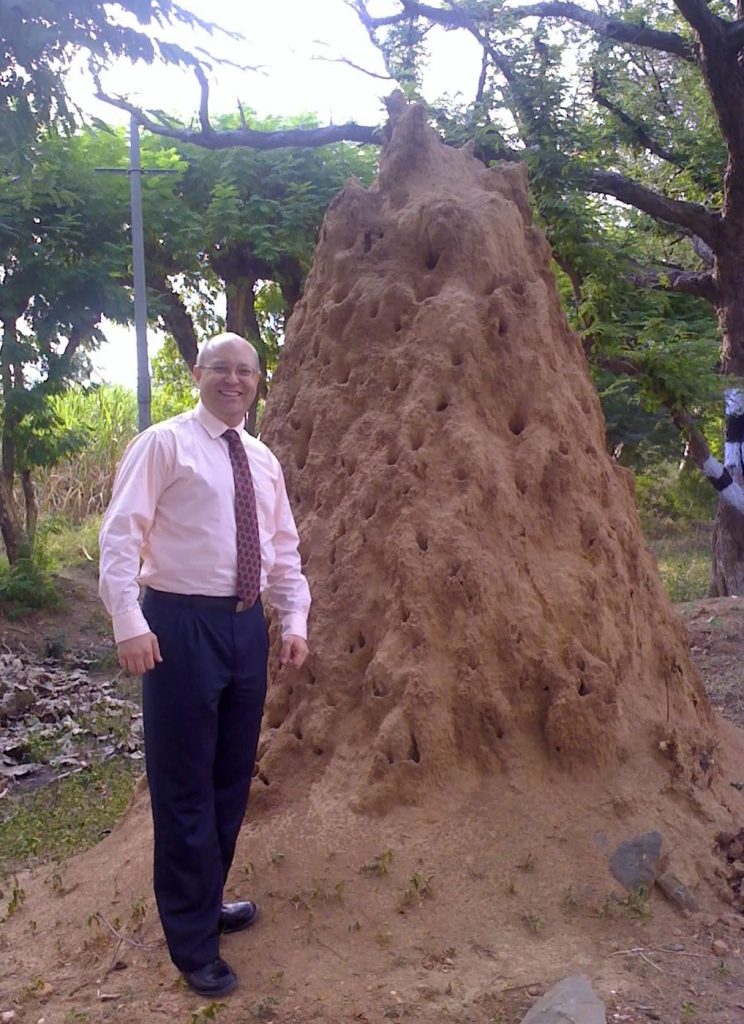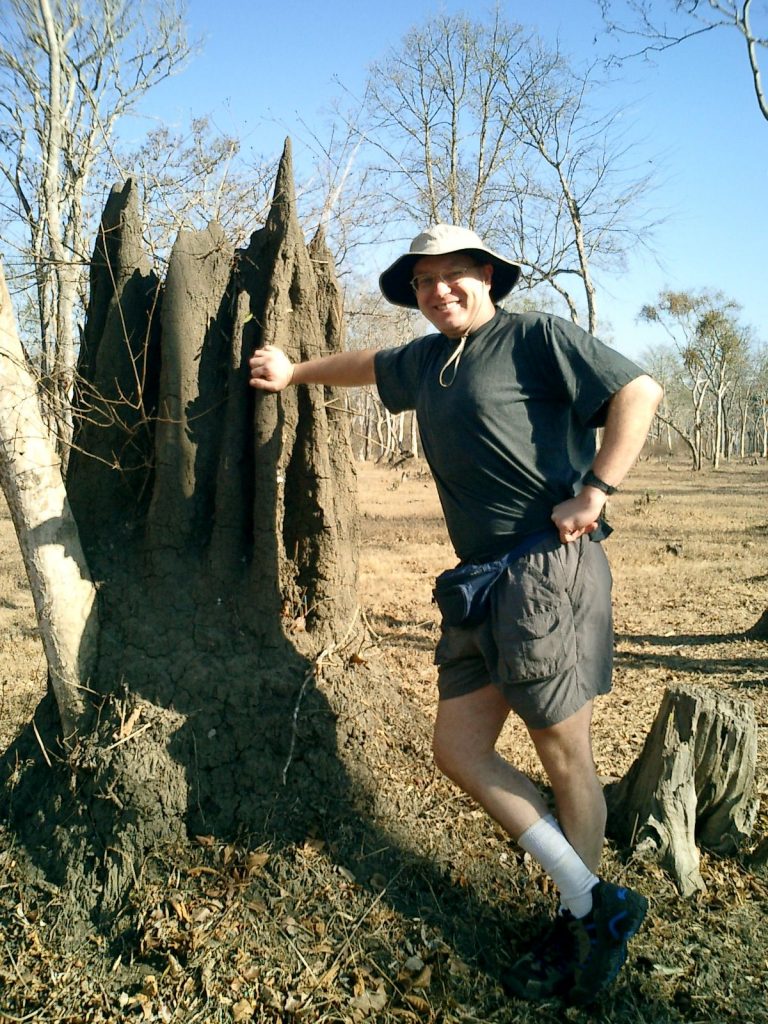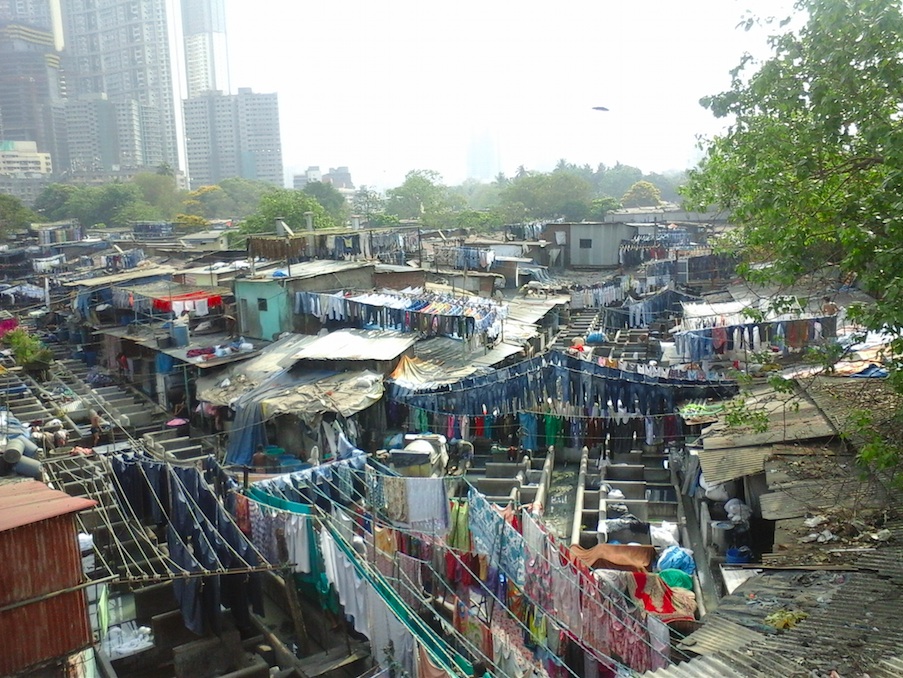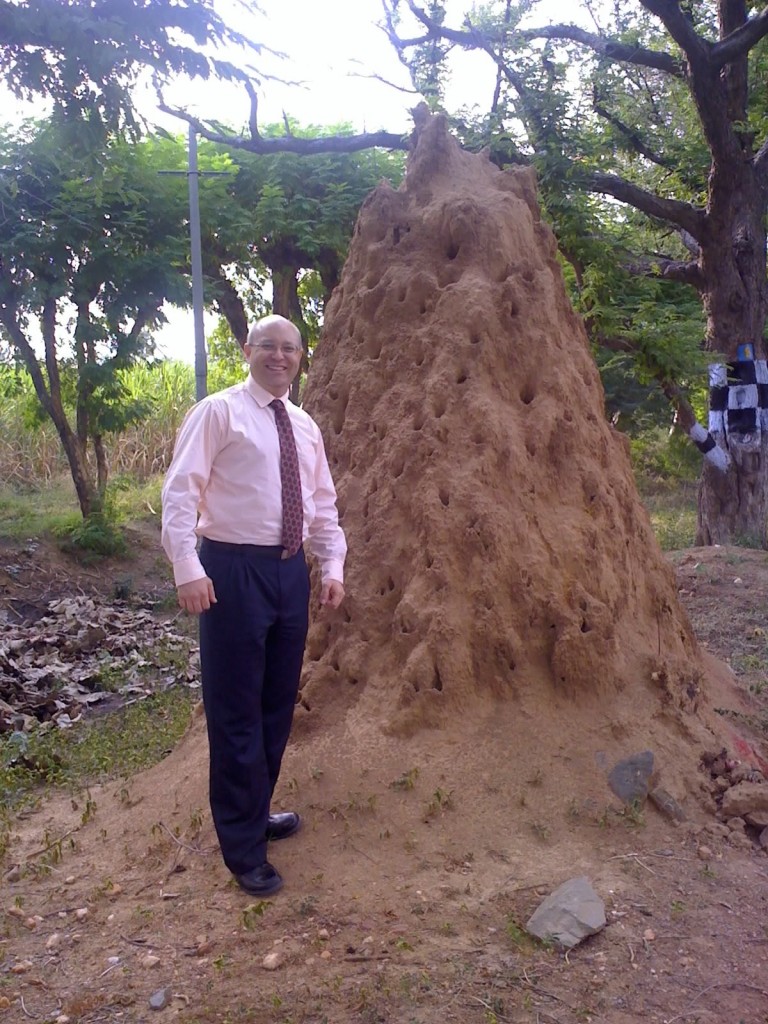Indians are fanatical about their cricket. Here you’ll see a fairly common sight during any important cricket match: pedestrian traffic has come to a standstill, and a huge mixed group of people strain to look at even the tiniest television set!
South India
Kotilingeshwara – An amazing South Indian temple
In the deep south of India, not too far from the Kolar Gold Fields and just on the border between Karnataka and Andhra Pradesh, is the amazing Shiva temple called Kotilingeshwara.
It is not a temple in any conventional sense of the word. It is more of a indoor / outdoor park, filled with thousands upon thousands of small, identical statutes called linga, which is actually a representation of the Indian god Shiva. Here you can see a few of them, with a huge statute of the sacred cow Nandi in the distance:
Interestingly, I arrived on the day of a festival, and thousands of visitors were expected and beginning to line up. But a cousin of a friend of mine is a police officer who is assigned to this temple, so he let us in early before the crowd. (That’s him above in the dark khaki clothes, carrying his big long stick that police offices in India are famous for.)
Here’s another look, showing some of them as large as a building (it’s one of the largest in the world), and others as small as tea cups:
I don’t know the details, but I think for the price of a donation to the temple you can arrange to have a lingam dedicated with your name.
Oh, and for those who think that Indian names are quite long and difficult, this name provides a wonderful segue to an upcoming post about Indian names: koti means 10,000,000, linga we talked about above, eshwara means god – hence the name Kotilengeshwara refers to the 10 million manifestations of the god Shiva.
Happy Cow
You just can’t take a bad photograph of a good cow!
This one is very happy because she is standing on the steps of the Chamundeshwari Temple.
Indian Aqueduct
If there is one thing that India has done longer and better than just about any other country, it is innovative aqueducts. Some of the most famous aqueducts are centuries old, such as in the historical city of Hampi; others are still intact after hundreds of years, dotting the rural Indian countryside.
And some of them are quite modern, such as the Varasun Aqueduct:
Helping to provide valuable water from the Kaveri River to farmers as part of a much longer (135 km) canal, the aqueduct is 1.8 kilometers long and towering at an unbelievable height of 16 m.
A True World Wonder – ಶ್ರವಣಬೆಳಗೊಳ
In my opinion, the 60-foot-tall statute of the Indian god Bahubali (sometimes called Gommateshwara), carved out of a single piece of granite and located high on a mountain, is without doubt one of the most amazing things I’ve ever seen.
Here’s the top part of his body – and if you look closely, you can see the visitors on the tower just above his head:
Here is the lower part of his body – and again, be sure to look at the size of the people near his toes:
But if you want to visit ಶ್ರವಣಬೆಳಗೊಳ, also known as Shravanabelagola, it won’t look like these pictures. I was VERY fortunate and priviledged to be able to visit during the Jain religious ceremony called Mahamastakabhisheka, which is only held every 12 years!
Unfortunately, there is so much about this holy site that I do not know. I’ve never been able to find any documentation about who created the statute and why, how long it took, and how they managed to transport it intact up a very high and very steep mountain.
Indian art
Somanathapura’s Chennakesava
There were two amazing things I remember about the Chennakesava Temple, just outside of Mysore. The first is how incredibly well preserved it is, considering it is 800 years old.
No matter where you live in India, it is amazing that the locals over the centuries have treated the ruins with such respect, so that so much is intact today.
But the most amazing thing I remember: this was my first experience at understanding how tough and robust people’s feet can become, if they spend enough time walking barefoot. The temperature of the ground was well over 60 C = 140 F, and yet this family showed no discomfort at all:
My guests and I could not spend more than just two or three seconds on the pavement in our bare feet. After I lived for a few years in India, spending most of my time barefoot, so too did my feet become tough and calloused – I once measured the thickness of my callouses and it was nearly 3/16 of an inch in some places – but I’m still not sure I could have done this!
What is just amazing is that most people living in the modern world, wearing modern shoes, have no idea about some things the human body was really designed to do!
INdog
While I lived in India I had an adopted dog. This looks like him, but this is not him:
These dogs are a common sight everywhere in India. They are called Indian Pariah Dogs, or INdogs for short, and sadly, most Indians I’ve met seem quite unaware just how remarkable these creatures are.
First of all, many scientists believe they are the oldest breed of dog in the world.
Second, no matter how hard humans try to control their population, still the INdogs win in the end, and the INdog population always rises or falls in tune with the available resources.
Construction yaks
Somewhere near the Commercial Street district, in Bangalore:
What’s so exciting about some countries like India is that public spaces are filled with people from a very wide spectrum of economic classes: manual laborers using animals working side-by-side with very high paid IT engineers. Amazing!
Cow
You just can’t take a bad photograph of a good cow!
This one walked down a long narrow street in Mysore, stopped briefly to look at me, then turned and continued along his way. Unbelievable. I hope he was successful in whatever he was trying to achieve.
Amazing Ants
I took this snap just north of Bangalore, on the way to the so-called Nandi Hills.
You can see my other Amazing Ants photographs here:
Bird on a donkey
The final resting place of three Apostles?
These are the famous Apostles, Saint James, Saint Peter, and Saint Thomas:
Technically, I am referring to Saint James, son of Zebedee, since there is a second apostle also named James. The Spanish people call Saint James by a different name, Santiago, and he is buried in a cathedral I visited in the Galician city of Santiago de Compostela:
Saint Peter is probably the most famous saint, having been killed not just by crucifixion, but by crucixion-upside-down, in this Roman square that I visited, now known as Saint Peter’s Basilica:
But I’m not sure if anyone really knows where Saint Thomas is buried. According to the locals, Saint Thomas travelled to India and eventually reached Chennai, having died and been buried somewhere quite close. There is a famous church I visited there, known Saint Thomas Mount:
Saint Thomas is known as the Patron Saint of India – but unfortunately there is some dispute as to whether these claims are true. I hope they are true, because it would make the people who believe them very happy.
So by coincidence and not by plan, I’ve visited what may be the final resting place of 25% of the twelve Apostles.
Amazing Ants
There is something quite frustrating about some local South Indian farmers I’ve met.
But first, this is the largest ant mound I’ve seen in India (or anywhere else for that matter):
I spotted this one just outside of Tiruchappalli (or more commonly called Trichy, as the locals call it). If you don’t know it, Trichy is famous for its white rice – and the locals say the taste is so good because of the special properties of the soil. So, I guess it would only be natural that the ants enjoy this great soil and build super-mounds like this one!
But what’s so frustrating about some local South Indian farmers? I could never find any farmers (or locals for that matter) who referred to these as “ant mounds” or “termite mounds.” If you ask the locals, they will always tell you they are “snake houses.” OK, probably they make nice homes for snakes – I don’t dispute that. But it always makes me wonder if they know who the builder was, not just some of the tenants!
You can see my other Amazing Ants photographs here:
Amazing Ants
Well, technically termites, not ants – and despite having lived a few years in Southern India, I still never learned much about the various species – but you can generally recognize them by the shape of their mounds. I discovered this one somewhere between Bangalore and Shravanabelagola.
I remember reading somewhere that these mounds grow on average as little as 1 cm per year – and if that’s true, these are very old mounds.
You can see my other Amazing Ants photographs here:
India’s glimpse into Europe’s past: the “Little France” of Mumbai
One reason I love India so much: India provides an amazing glimpse into the history of Europe.
Shown here are the Dhobi Ghats, or clothes washing area, of Mumbai. What 99.99% of most tourists don’t realize is that Europe had these places, too, and you can find a picture of one in my recent blog about Petite-France. Today, the washing area in Petite-France is covered in flowers and lined with street cafés; but a few hundred years ago, clothes were washed in segments along the river: the clothes for the rich people upstream, and the clothes for the lesser privileged downstream. So what you see above is likely much cleaner and nicer than what it would have looked like in France!
My biggest gripe: Europe evolved slowly, and these old places were slowly transformed and retained. In India as in the U.S., the high-speed of big urbanization means that interesting cultural places (such as the Dhobi Ghats) are often developed right out of existence.
Learning from the ants
I’ve always been fascinated by termite mounds as an example of emergent behavior – but as far as I can tell (mainly by the millions of little black ants swarming all over it), this is a true ant mound, not a termite mound. I took this picture in Tamil Nadu, not too far outside of Tiruchirappali, in the far south of India.
An unresolved mystery I want to clear up one of these days: when I talk to the village locals, they invariably refer to these structures as “snake houses” and not “termite houses.” I think we both agree snakes live here – but I’ve never really understood if the villagers know these structures are created by insects, not reptiles.
If anyone has any links to the termites and ants of southern India, please do share them with me! I’ve seen some very exotic architectures, and I’ll post more pictures as time permits.
Amazing coincidence!
Scientists will tell you there is nothing special about coincidences. As we live our lives we experience a continuous stream of sensory inputs – so it’s only natural and expected that from time to time that our internal pattern recognition systems will alert us that some random event triggers a meaningful response.
But still and all . . . I find the following story almost too incredible to be true.
Just a few weeks ago I was was in Mumbai. With well over 15 million inhabitants it’s slated to become the world’s largest mega-city by the year 2020. And on one evening I was enjoying the warm weather, walking down a street in the posh district of Hiranandani, when I accidentally ran into a friend and previous colleague of mine, Sandhya! The last time we had seen each other was in 2007 – when she and I were both in Bangalore, a city some 500 km to the south of Mumbai. I had no idea she moved to Mumbai, and she had no idea I was there on business.
Is this an amazing coincidence?!
We agreed to meet a few days later for coffee. At the time, back in the day, she was the best software engineer I knew. (At a very young age she absolutely mastered a very complex document management system, Documentum.) And I was both impressed and thrilled that she continued in her career, now a senior project manager leading huge international projects with dozens of people for the Indian company Cognizant! Way to go, Sandhya!
